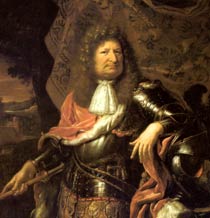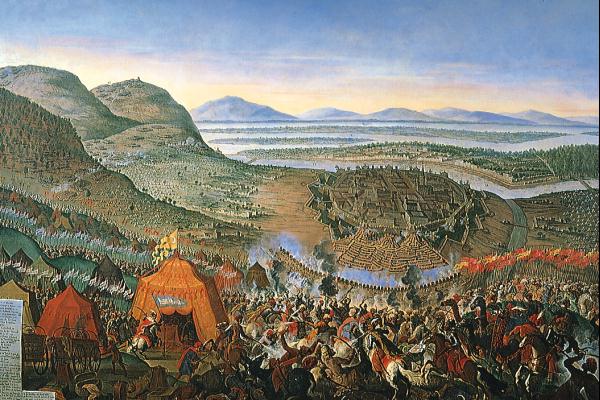Textbook reading: Birn, Chapters 3 & 4. This week, we delve more deeply into the particulars of post-1648 political life in Europe; patterns of restoration after mid-century on the continent and in Britain; the emerging balance-of-power system in louisquatorzian Europe; patterns of continuity and change in the domestic politics of European states. Prepare in advance for discussion in class: Sir Robert Filmer, Patriarcha (1680) [Canvas] and Daily Life at the Court of the Sun King [Canvas].
Absolutism and its Alternatives
I. Discussion: Sir Robert Filmer, Patriarcha
Image right: Frontispiece to the 1651 edition of Thomas Hobbes, Leviathan. Source: University of Adelaide.Image: Cardinal Jules Raymond Mazarin (1602-1661)
Image: The Beheading of King Charles I (1600-1649)II. Abolutism in Theory
A. Patriarchal Absolutism: Jean Bodin (1530-1596)
B. Social Contract Absolutism: Thomas Hobbes (1588-1679)
C. Divine Right Absolutism: Jacques-Bénigne de Bossuet (1627-1704)
 |
III. Absolutism
in Practice Map: The Swedish Empire, ca. 1660 Image left: Friedrich Wilhelm I, Elector of Brandenburg-Prussia (1640-1688). In the German historical tradition, “The Great Elector”is credited with the most consistently absolutist approach to governance among the princes of Germany. Friedrich Wilhelm established a standing army; was an advocate of mercantilism, monopolies, subsidies, tariffs, and internal improvements. Most importantly, Friedrich Wilhelm laid the foundation of a service nobility in his realm. Image source: Preussen.de. |
IV. Alternatives to Absolutism
A. Aristocracy Triumphant: England after the Restoration
B. Oligarchy Ascendant: The Dutch RepublicImage: The Russian "Table of Ranks" (1722)
Image: Tsar Peter shearing the beard of an "Old Believer"Image: Portrait of William of Orange, Stadhouder of the Dutch Republic (1672-1702) and King of England (1688-1702).
Image: King James II (1633-1701, r. 1685-1688)
Map: The Dutch Republic (1705)
Dirck van Delen (1605-1671), The Great Hall of the Binnenhof, The Hague, during the Great Assembly of the States General in 1651 (1651). Oil on panel, copper. 52 x 66 cm. Rijksmuseum Amsterdam, Object number SK-C-1350. In 1651 the full States General met from January to August to debate the constitutional situation within the Republic. This was necessary following the sudden death of Stadholder Prince William II in November 1650. This extraordinary assembly took place in the Great Hall of the Binnenhof in The Hague, the former court of the counts of Holland, built in the thirteenth century. Its present name, 'Ridderzaal' or Knight's Hall, is nineteenth-century.For this gathering of more than three hundred delegates the Great Hall was specially arranged. The shops and stalls along the walls were removed. Benches for the delegates were fixed down the sides of the hall. Opposite the hearth, a table was placed for the presiding officials. The table in the foreground, with the inkstand and pens, books and hourglass, may be the actual table. The tablecloth bears the arms and the motto of the Republic: CONCORDIA RES PARVAE CRESCUNT (Through Unity the Small Become Strong). A copper plate is attached to the painting with hinges. When the flap is opened, the assembly is obscured from view by a wall of paintings. The banners in the hall were not hung specially for the assembly. Most had hung there for more than fifty years. These were the banners Prince Maurice had captured from the Spaniards at the battles of Turnhout (1597) and Nieuwpoort (1600). It was suggested that the banners and other trophies be removed for the duration of the sitting: after all, peace had been signed with Spain only three years before. But the opposite happened. The existing trophies were dusted and others were added: Spanish and Portuguese naval flags, recognisable from the crowned coats of arms. They had been captured at the battles of Gibraltar (1607) and The Downs (1639). Image and commentary source: Rijksmuseum Amsterdam.
.jpg)
.jpg)
 III.
Absolutism in France under Louis XIV
III.
Absolutism in France under Louis XIV